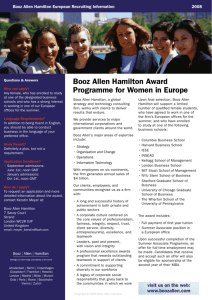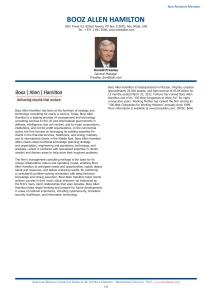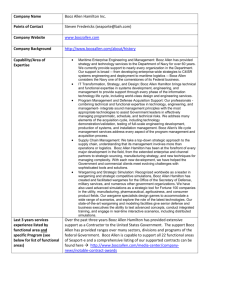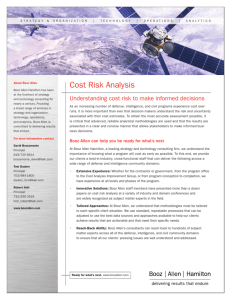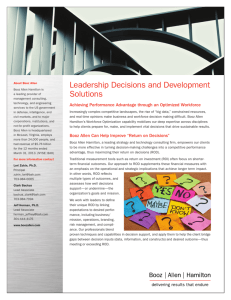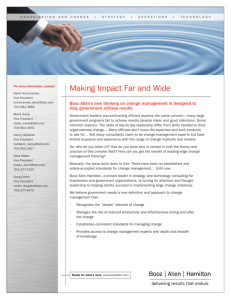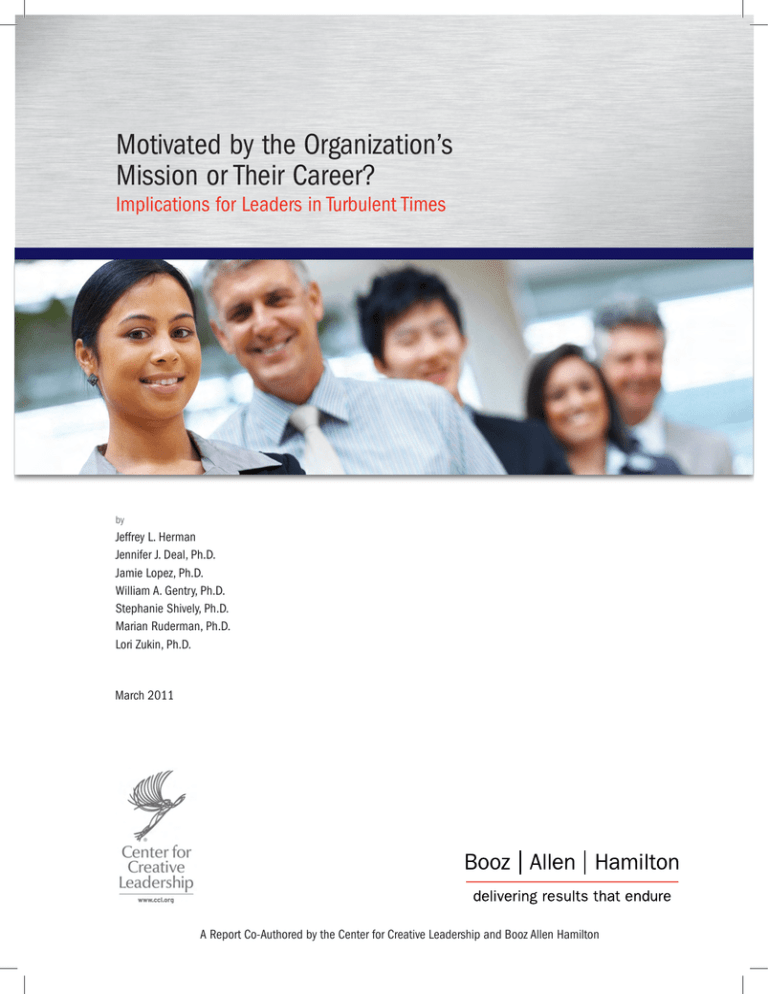
Motivated by the Organization’s
Mission or Their Career?
Implications for Leaders in Turbulent Times
by
Jeffrey L. Herman
Jennifer J. Deal, Ph.D.
Jamie Lopez, Ph.D.
William A. Gentry, Ph.D.
Stephanie Shively, Ph.D.
Marian Ruderman, Ph.D.
Lori Zukin, Ph.D.
March 2011
A Report Co-Authored by the Center for Creative Leadership and Booz Allen Hamilton
Center for Creative Leadership
Center for Creative Leadership
Motivated by the Organization’s
Mission or Their Career?
Implications for Leaders in Turbulent Times
Rising competition for talent along with federal pay and
hiring freezes are bringing increased pressure on leaders
to motivate and retain employees. This article describes
research on what motivates employees to choose to
work where they do and describes how leaders can use
this information to engage and retain a workforce as
competition for talent increases. The authors describe three
employee profiles—Mission focused, Career focused, and
those stuck with no other options—and how leaders can
motivate and retain them.
Introduction
A tough economy has caused a large number of
employees to feel that they have limited job options;
and as a result, they are not actively pursuing other job
Leadership can happen anywhere within an
organization, at any level, and in any job
category. Some leaders lead through formal
authority; others lead through influence and
interpersonal networks. Because people at
every level can act as leaders, and because
people at every level sometimes need
leadership (rather than just people at lower
levels), this report offers recommendations
to those whose intent is to lead, regardless
of their formal role in their organization.
Leadership recommendations are therefore
not aimed at senior executives, front-line
supervisors, or any other specific group. We
refer to people at any level who choose to act
as leaders to motivate and influence others.
1 Meyer, J. P., Becker, T. E., & Vandenberghe, C. (2004). Employee commitment and motivation: a conceptual analysis and integrative model. Journal of Applied Psychology, 89(6),
991-1007.
opportunities. However, as the economy improves—and
there is evidence of improvement—retaining and engaging
valuable employees will soon need to be among the
top priorities of leaders in both government and private
industry. What can leaders do to retain and engage
employees in a complex and turbulent economy?
Leaders who understand and address what motivates
their employees are more likely to hold on to their best
people and maximize performance by all employees.1
Compensation and benefits alone neither retain good
employees nor motivate them to contribute their very
best. In many cases, an employee’s motivation comes
down to his or her relationship with an individual leader.
The quality of that relationship depends in large part on
how well the leader understands the employee and his or
her motivation.
The Center for Creative Leadership and Booz Allen
Hamilton conducted research to identify the relationship
between why people are in their current positions and how
motivated and committed they are to their organization.
The results shed new light on what drives employees
in public and private institutions, and how leaders can
motivate and retain employees through continuing
complexity and change.
“Smart agency leaders should strive to
understand the reasons that individual
employees and groups or categories of
employees leave, and then to use that
information to improve aspects of the
workplace environment they find lacking.”2
2 http://ourpublicservice.org/OPS/publications/viewcontentdetails.php?id=154
1
Center for Creative Leadership
What Drives Employees Today:
Mission or Career?
Federal government employees are often described as
primarily Mission focused, and their leaders frequently
rely on the mission to motivate them. From warfighters to
emergency responders to scientists, the mission is the
shared goal that breaks down barriers, drives collaboration,
and sustains careers through immense challenges and
tangles of red tape.3 Some believe that private industry
is very different in that leaders there focus on career
advancement and compensation as motivators for people
presumed to be driven primarily by personal ambition.
But for many people, work is not just about money or
promotions; it is about making a difference and the
mission of their organization. Research suggests that
though some people are focused on money, compensation
is not the primary reason people stay in their jobs and
work hard. So what is?
When thinking about how people are motivated, one
way to group people is according to whether they stay
in their position because of the organization’s mission
(Mission focused), because staying in the job furthers
their personal career (Career focused), or because
they currently see no other options for employment
(No Options). How people answer the question about
why they stay in an organization is strongly related to
their motivation and how committed they are to their
organization. Leaders who understand how these three
orientations to the current job affect perceptions and
behavior will be more equipped to use available resources
to motivate their teams.
3 Wright, B. E. (2007). Public service and motivation: does mission matter? Public
Administration Review, 67(1), 54-64.
4 For additional information on survey methodology and sample, see Appendix 1.
2
Leaders must adapt their styles as needed
to employees who are Mission focused,
Career focused, and stuck with a perceived
lack of options.
To help leaders understand how these three orientations
to the current job affect perceptions and behavior, we
asked 1,133 people employed in the United States
between July 2010 and October 2010 to tell us whether
they were in their current position because of the mission
of the organization, because staying in the job furthered
their personal career, or because they currently saw no
other options for employment. At the same time, we
asked them about their—
• Commitment to the organization
• Job and pay satisfaction
• Perceived support from the organization
• Personal motivation
• Feelings about the organizational structure
• Opportunities for development
• Intention to remain with the organization, and
• Beliefs about what leaders should do and be.4
Out of 326 federal government employees, 52 percent
responded that they were motivated to stay primarily
because of their organization’s mission; 27 percent
responded that they were motivated to stay primarily
because of career opportunities; and 21 percent
responded that they stayed because they had no other
attractive options (see Exhibit 1 on page 3). Out of 807
participants working outside the federal government (in
for-profit and not-for-profit organizations), 53 percent
responded that they were motivated to stay in their current
jobs primarily because of their organization’s mission;
25 percent responded that they were motivated to stay
primarily because of the career opportunities; and 22
percent responded that they were staying in their current
jobs because they had no other attractive options. Missionfocused and Career-focused employees are found in equal
proportion in federal and nonfederal sectors, at all levels of
5 In for-profit organizations, mission-driven types are more frequently found at higher levels
in the organization. Whether they are at higher levels because they are mission driven or
whether they are mission driven because they create the mission because they are at the
level to do so is an unanswered question. To answer that question would require longitudinal data not currently available.
Center for Creative Leadership
Exhibit 1: Motivation to Stay in Current Job in Federal
and Non-Federal Organizations
0.6
0.5
0.4
0.3
No Options
0.2
Career
0.1
Mission
0.0
Federal
Non-Federal
Source: Center for Creative Leadership and Booz Allen
the organization,5 in both genders, and across generations
(e.g., Baby Boomers, Generation X, and Millennials) and
races.
The Impact of Being Mission vs. Career
Focused6
On average, both Mission- and Career-focused employees
reported being committed to the organization, having
high job satisfaction, and being strongly motivated. They
reported that they felt supported by their supervisors and
the organization, believed they had good opportunities
to develop within the organization, and were unlikely to
leave their organizations. Fundamentally, leaders benefit
by working with both types of employees because they are
committed, intrinsically motivated, and intend to stay with
the organization. Investing in the development of both
types of employees is a good bet.
How Are Mission-Focused and Career-Focused
Groups Different?
Mission-focused employees felt more supported by the
organization than Career-focused employees. Higher
levels of perceived organizational support have been
shown to be related to higher job satisfaction, lower
stress, higher employee commitment, greater retention,
and higher performance—all of which result in greater
employee and organizational effectiveness.
Mission-focused employees reported feeling greater
commitment to the organization than Career-focused
employees. Higher levels of organizational commitment
have been shown to be related to reduced intentions to
turnover and increased job involvement.7
6 No Options people are so different that they will be discussed in a separate section.
7 For a review see Kacmar, K.M., Carlson, D.S., & Brymer, R.A. (1999). Antecedents and
consequences of organizational commitment: a comparison of two scales. Educational and
Psychological Measurement, 59, 976-994.
Mission-focused employees reported greater job
satisfaction than Career-focused employees. Higher
levels of job satisfaction have been shown to be related
to reduced absenteeism8 and more organizational
citizenship behaviors,9 both of which help improve
organizational productivity.
Which of these am I? Ask yourself the
question we asked the respondents: Are
you in your current position because of the
mission of your organization, because the
job furthers your career, or because you are
stuck and have no other options? You may not
see any of these as 100 percent accurate,
so allocate a percentage to each. The next
question is how important each of these is
to you. Not everyone feels the same need to
be dedicated to the mission or their career.
Many employees are happy being dedicated to
their career and feel they make a difference
regardless of the organization’s mission.
Others feel that a strong connection to the
mission is what matters, and that building a
career is a hassle more than a goal. However,
if you find yourself mostly stuck in the No
Options category, you need to act to improve
your situation. Our research clearly shows that
employees who feel stuck with no options face
a number of challenges, including more friction
with organizational systems and reduced
perceptions of effectiveness. Getting “unstuck”
will require effort and creativity on your
part—and the leadership of others can offer
valuable support. As a leader, understanding
your own orientation toward mission, career,
and a lack of options will help as you motivate
your employees.
8 Wegge, J., Schmidt, K., Parkes, C., & van Dick, K. (2007). ‘Taking a sickie’: Job satisfaction and job involvement as interactive predictors of absenteeism in a public organization.
Journal of Occupational and Organizational Psychology, 80, 77-89.
9 Organ, D. W., & Ryan, K. (1995). A meta-analytic review of attitudinal and dispositional
predictors of organizational citizenship behavior. Personnel Psychology, 48, 775-802.
3
Center for Creative Leadership
Mission-focused employees reported possessing
greater personal political skill than did Career-focused
employees. This means Mission-focused employees may
be more effective at navigating the political environment
within the organization.10
Mission-focused employees reported experiencing
less political behavior within their organizations. The
experience of political behavior within organizations
can lead to lower organizational commitment and lower
intrinsic motivation. Mission-focused employees may
report less political behavior because they experience
less of it, or because they are better at managing it.
Either way, their experience of political behavior within
the organization likely has less of a negative effect
on their organizational commitment than it does on
Career-focused employees.
Mission-focused employees reported somewhat higher
intrinsic,11 and lower extrinsic,12 motivation than Careerfocused employees. Intrinsic motivation comes from
pursuing personally meaningful objectives and is closely
Do people leave their jobs when the
economy improves? Some leave, but most
stay. Employees who reported that they had
development opportunities available, were
committed to their organization, felt supported
by their supervisor and their organization, and
were satisfied with their jobs were unlikely
to identify the current economic conditions
as a reason for remaining where they were.
Conversely, employees who intended to
leave their organization identified the current
economic conditions as a reason for why
they had not left yet. This is good news for
employers and for leaders: Mission and Career
respondents generally reported they intended
to stay with their organization and did not
identify the economy as an influence on their
decision to work for their current employer.
4
10 Ferris, G. R., Davidson, S. L., & Perrewé, P. L. (2005). Political Skill at Work: Impact on
Work Effectiveness. Mountain View, CA: Davies-Black Publishing.
11 Intrinsic motivation is defined as finding joy in work.
12 Extrinsic motivation is defined as the extent to which one is motivated by money and
other tangible rewards.
associated with productivity, engagement, and innovation.
Extrinsic motivation comes from pursuing goals that are
motivated by demands, requirements, or obligations.13
The implication is that there is a subtle difference in
the type of motivation that Mission- and Career-focused
people bring to their jobs.
These distinctions between Mission- and Career-focused
employees highlight different motivations, perceptions,
attitudes, and behaviors. Earlier, we noted that Missionand Career-focused employees appear in similar
proportion in all types of organizations, from federal
government to private industry, and across levels of
management responsibility. Leaders who recognize and
leverage the value of both Mission- and Career-focused
employees in both federal government and private
industry, and at all levels of management responsibility,
will benefit their organizations and their employees.
No Options: A Different Perspective
In comparison with Mission- and Career-focused
employees, those employees who described themselves
as having “no other options” for employment appeared
stuck in many ways. These employees reported lower
commitment to their organizations, lower intrinsic
motivation, less job satisfaction, and less support from
their organizations and supervisors than Mission- or
Career-focused employees. They reported that the
systems in their organizations limited the effectiveness of
their own leadership behavior, no matter what they tried
to do; and they believed they had less support from their
organizations and supervisors than did Mission- or Careerfocused employees. Despite these differences, employees
reporting “no options” did not report working fewer hours
than Mission- or Career-focused employees. They did,
however, report themselves more likely to quit than either
Mission- or Career-focused employees.
Practical Ways that Leaders Motivate: Creating
Developmental Opportunities and Good
Leadership
How can leaders motivate and retain Mission- and Career
focused employees—and what can leaders do with
employees who feel stuck with no options? Employees
13 Though Mission-focused employees expressed greater intrinsic motivation than did
Career-focused employees, they do not appear to work more hours. Number of hours
worked was found to be a direct result of organizational level: the higher a respondent was
in his or her organization, the more hours s/he reported working, regardless of their focus.
Center for Creative Leadership
are motivated both by the opportunities they have and
by their leaders’ behaviors. Effective leaders in all types
of organizations can influence employee motivation by
helping find good learning and development opportunities
for them and by leading more effectively. Leaders will
be able to motivate a wider range of employees by
ensuring that they provide opportunities that appeal to
Mission- and Career-focused employees, and that they
look for ways to alter the perceptions—or the realities—of
employees stuck with no options.
Learning Opportunities
One of the most important actions leaders can take is
to help employees find opportunities that will help them
build a career and support the mission. Opportunities to
develop new and better skills are critical to motivation
and retention in the workplace.14 Our research indicates
that having access to learning opportunities is strongly
related to being engaged at work for Mission-focused
and Career-focused employees. Both types reported
that they had access to learning opportunities, but
Mission-focused employees reported having more access
and also felt more committed to the organization than
did Career-focused employees. Learning opportunities,
such as those described below, may not always directly
result in employees being Mission focused, but our
research shows that those employees who say they have
more access to learning are more committed to the
organization’s mission.
“Researchers have found growth opportunities to
be an important motivator for employees to stay
at their jobs. These opportunities provide benefits
to the organizations, as people learn and master
new skills and knowledge.”15
—Partnership for Public Service and
Booz Allen Hamilton
These findings likely reflect a self-reinforcing spiral. In
part because of access to learning and developmental
activities, Mission-focused people identify and pursue
developmental opportunities, thus acquiring new skills
and experiences. They then leverage their increased
capabilities for both professional advancement and
organizational impact. Career-focused people may need
more prompting to get into the same spiral but are
clearly primed to move that direction when provided with
opportunities to learn and develop.
People stuck with No Options are likely to be more
difficult to move into this positive spiral. This research
found No Options respondents to be neutral about
whether they had the opportunity to develop but were
positive about learning within the organization in general.
People complain that organizational
systems get in their way and hamper their
motivation. Are systems the problem, or
are the people who complain mainly those
who are otherwise just unmotivated? Our
research found that many people believe that
organizational systems do get in their way, and
those people are not just the ones who are
generally dissatisfied with their job. Though
No Options respondents are more likely to
say that organizational systems get in their
way, Mission- and Career-focused people also
identify organizational systems as limiting their
effectiveness. This means that organizations
can benefit substantially by identifying where
even the best people believe the systems limit
effectiveness and by altering those systems to
be less of an impediment. When organizational
systems are altered to reduce their negative
impact on employee effectiveness, another
positive spiral can begin: people experience
the organization hearing their concerns and
taking steps to address them, which results in
the employee thinking more positively about
the organization, which results in improved
employee commitment, which results in
improved motivation, which results in increased
employee effectiveness.
14 Donohue, R. (2007). Examining career persistence and career change intent using the
career attitudes and strategies inventory. Journal of Vocational Behavior, 70, 259–276.
15 http://ourpublicservice.org/OPS/publications/viewcontentdetails.php?id=154
5
Center for Creative Leadership
employee. Connecting the employee with the opportunity
to have impact and continued development demonstrates
a commitment to that employee—whether Mission or
Career focused. Critically, this combination of opportunity
and commitment can keep high potentials and high
performers from sensing they are stuck with No Options.
This combination is especially important when few actual
promotions are available.
Providing them with more opportunities to develop and
prompting them to follow up on such opportunities could
tip the scales and open doors to new perceptions of
opportunities—and consequently to new attitudes about
the organization in general and the work specifically. A No
Options employee may have reached a career plateau—a
level with no apparent prospects, at least from his or her
vantage point.16 No Options employees may have become
disconnected with the mission, possibly by losing “line of
sight” to how their job contributes to the overall mission
of the organization.17 In cases where an employee can
take action to overcome career challenges or reconnect
with the mission, leaders can help “unstick” employee
perceptions by identifying valuable opportunities and
leading effectively.
Developmental Assignments. Developmental assignments
and job rotations are powerful motivators for employees.
When leaders in formal supervisory roles provide
a special assignment or a job rotation opportunity,
it furthers the person’s career development. Such
opportunities also result in a better understanding and
contribution to the organization’s wider mission by the
16 Chao, G. T. (1990). Exploration of the conceptualization and measurement of career
plateau: a comparative analysis. Journal of Management, 16, 181–193.
17 http://www.ourpublicservice.org/OPS/publications/download.php?id=147
6
Mentoring/Coaching. Employees can be motivated by
being provided with the opportunity to have a mentor
or coach. Leaders can connect staff with mentors
or coaches who can help the employee identify new
opportunities, learn strategies for advancing, and call the
attention of higher-level executives to them. Mentoring
and coaching provide powerful complements to other
learning opportunities by sustaining and expanding on
their benefits over time. Further, there is evidence that
the mentors themselves benefit from engaging in a
mentoring relationship,18 and leaders can motivate even
senior people in organizations by providing opportunities
to mentor junior employees. Mentors benefit by having
enhanced visibility within the organization, opportunities
to shape their leadership and management skills, and a
lasting professional network.
Recognition. One of the simplest ways a leader
can motivate others is to recognize efforts and
contributions.19 Unlike pay raises and promotions, a
verbal “thank-you” or an e-mail to share the mission
impact of a recent project taps into the internal
motivations that are inherent to the positive spiral of both
mission and career motivation. Leaders who share credit
for mission impact and note the positive career directions
of others foster a positive, motivating climate.
Leadership
Effective leadership is critical to motivation and retention,
but the question is often what type of leadership is
most likely to be motivating. Our research shows that all
employees (Mission, Career, and No Options) believe that
the same characteristics result in effective leadership:
charisma, team orientation, encouraging participation, and
being humane.
18 E.g., Lentz, E., & Allen, T. D. (2009). The role of mentoring others in the career plateauing phenomenon. Group & Organization Management, 34, 358-384.
19 Luthans, K. (2000). Recognition: A powerful, but often overlooked, leadership tool to
improve employee performance. Journal of Leadership Studies, 7, 31-39.
Center for Creative Leadership
While all types of people believe that those characteristics
result in effective leadership, they do not all believe
it to the same extent. As shown in Exhibit 2, all types
of people believe that leaders who are Charismatic,20
Humane Oriented,21 and Team Oriented22 are more
effective, but Mission-focused people think each is more
important for good leadership than do Career-focused or
No Options people. Finally, all types of people believe that
leaders who are Participative23 are substantially more
effective than those who are not. Fewer people believed
that being Hierarchical24 or Autonomous25 were effective
leadership characteristics.
Conclusion
Critical competencies for leader effectiveness include
sharing information, providing help, encouraging
collaborative behavior among team members, and having
the ability to inspire commitment to values or to a
mission.26 A common thread among these competencies
that are critical to leader effectiveness is the emphasis
on the interpersonal nature of leadership that enables
leaders to adapt their styles to the employees’ different
orientations. Leaders who bring charisma, humane
and team orientation, and participative approaches
that enable them to adapt to the employees’ different
orientations will be better able to motivate and
retain employees.
Booz Allen Hamilton:
Jeffrey L. Herman
Associate
herman_jeffrey@bah.com
301/444-4176
As competition for talent rises, leaders cannot afford to
disregard what motivates and connects employees to
their organizations. Leaders must be able to adapt their
styles to motivate and retain Mission-focused and Careerfocused employees, and to reengage employees who
are stuck without options. Leaders who succeed stand
to realize meaningful, long-term competitive advantage
for their organizations as well as individual benefit for
their employees.
For additional information, please contact:
Center for Creative Leadership:
Jennifer J. Deal, Ph.D.
Senior Research Scientist
dealj@ccl.org
858/638-8049
Exhibit 2: Leadership Preferences Across Motivations
5.0
4.5
4.0
3.5
3.0
No Options
2.5
Career
2.0
Mission
1.5
1.0
Charisma
Humane
Oriented
Team
Oriented
Participative
Source: Center for Creative Leadership and Booz Allen
20 Charismatic: The degree to which a leader inspires others around a vision or values,
motivates his/her followers, and maintains high performance expectations.
21 Humane oriented: The degree to which a leader is supportive, compassionate, considerate, and generous. It has to do with being humble and concerned about the well-being of
others.
22 Team oriented: The degree to which a leader effectively builds and manages teams that
work together to achieve a common goal, emphasizes the growth of the team, and instills
pride, loyalty, and cohesion among team members.
23 Participative: The degree to which a leader shares power and allows others to take part
in decision making and take actions based on decisions made.
24 Hierarchical: The degree to which a leader influences others by formal status, authority,
or position power.
25 Autonomous: The degree to which a leader is independent, individualistic, or self-reliant.
26 Gentry, W. A., Harris, L. S., Baker, B. A., & Leslie, J. B. (2008). Managerial skills: What
has changed since the late 1980’s? Leadership & Organization Development Journal, 29,
167-181.
7
Center for Creative Leadership
Appendix: Report Methodology and Sample
This Center for Creative Leadership and Booz Allen
Hamilton report was a joint initiative conducted as part
of the Center for Creative Leadership’s World Leadership
Survey research initiative.27 The sample for this report
was collected from July 2010 through October 2010.28
This sample includes—
• 1,133 respondents from the United States
• 326 respondents from the federal government
• 807 respondents from organizations other than the
federal government, ranging in size from very small
(1 to 9 employees) to very large (10,000 or more
employees)
• 51 percent male, 49 percent female
• 79 percent white, 21 percent nonwhite
–– “Nonwhite” includes 9 percent Black, 4 percent
Asian, and 7 percent “Other” (Hispanic,
Multiracial, Other)
8
27 The World Leadership Survey has collected data online in English since its inception
in March 2008, and currently collects data in 15 additional languages. Participants in the
research come through partner organizations, interested individuals, and enrollment in CCL
programs. Participants fill out a survey online that is hosted by Clear Picture Corporation
and takes them approximately 20 minutes. In thanks for their participation, participants
receive a free CCL Guidebook to download immediately upon completion of the survey.
Questions about the survey are sent to the World Leadership Survey e-mail account at
WorldLeadershipSurvey@ccl.org.
• Generations: 95 percent between the ages of 22 and
65 (Millennials, Gen X, and Baby Boomers)
• Organizational level: 19 percent of the sample
indicated that they were at the top (C-level), 11
percent described themselves as an executive, 17
percent upper management, 29 percent middle
management, 18 percent professional, and 6 percent
first-level management.
Differences Between the Federal and Nonfederal
Samples
• There were more C-level and executives in the
nonfederal sample, and more managers and
professionals in the federal sample.
• There were more Baby Boomers in the federal sample,
and more Gen Xers in the nonfederal sample.
• There were no differences in gender or racial
distribution between the samples.
28 It is important to note that this is not a random sample of North American managers
or employees either in the federal government or in for-profit industries, and therefore it is
likely not fully representative of the working population.
Center for Creative Leadership
9
Center for Creative Leadership
About the Authors
10
Jeffrey L. Herman is an Associate at Booz Allen
Hamilton based in Rockville, Maryland, and serves
as the team lead for leadership development
strategy and research. He supports clients across
the federal government in the design, development,
delivery and evaluation of leadership development
and other human capital interventions. Mr. Herman’s
research centers on global and adaptive leadership
development.
Jamie Lopez, Ph.D., is an Associate and IndustrialOrganizational psychologist at Booz Allen Hamilton,
where he leads the leadership assessment team.
He currently assists a variety of clients across the
federal government on issues related to leadership
competencies, selection, and assessment. His
research focuses on applicant dissimulation
within noncognitive measures and operational
psychology areas.
Jennifer J. Deal, Ph.D., is a Senior Research Scientist
at the Center for Creative Leadership (San Diego) who
manages the World Leadership Survey globally. In
2002 Dr. Deal co-authored Success for the New Global
Manager (Jossey-Bass/Wiley Publishers), and has
published articles on generational issues, executive
selection, cultural adaptability, global management,
and women in management An internationally
recognized expert on generational differences, she
has spoken on the topic on six continents; and her
second book Retiring the Generation Gap (JosseyBass/Wiley Publishers) was published in 2007.
William A. (Bill) Gentry, Ph.D., is currently a Senior
Research Associate at the Center for Creative
Leadership (Greensboro), coordinator of internships
and postdocs, and also an adjunct assistant at
several universities. Dr. Gentry has several areas of
research interest, including survey development and
analysis, and leadership and leadership development
across cultures.
Center for Creative Leadership
Stephanie Shively, Ph.D., is a Senior Consultant at
Booz Allen Hamilton with experience in a number of
areas to include leadership assessment, selection,
and development. She is currently working with clients
in the federal government to strengthen leadership
capabilities and to support other talent management
initiatives.
Marian Ruderman, Ph.D., has broad expertise with
25 years in the field of leadership development. At
the Center for Creative Leadership, she has held a
variety of research and management positions. Dr.
Ruderman has written several books and developed
several assessments and products, including the
Global Leader View and the WorkStyle Profile. She
is currently a Senior Fellow and Director, Americas &
EMEA (Europe, Middle East, and Africa) Research at
the Center for Creative Leadership.
Lori Zukin, Ph.D., is a Principal at Booz Allen
where she leads the firm’s leadership development
community of practice to develop research and
thought leadership on the topic. She has worked with
numerous leaders in the federal government with a
recent focus on the Intelligence Community.
The authors acknowledge the valuable contribution of Luke Brooks-Shesler and Sarah Stawiski in the drafting of
this report.
11
Center for Creative Leadership
About Booz Allen
Booz Allen Hamilton has been at the forefront of strategy
and technology consulting for nearly a century. Today,
the firm provides professional services primarily to US
government agencies in the defense, intelligence, and
civil sectors, as well as to corporations, institutions, and
not-for-profit organizations. Booz Allen offers clients deep
functional knowledge spanning strategy and organization,
technology, operations, and analytics—which it combines
with specialized expertise in clients’ mission and domain
areas to help solve their toughest problems.
Booz Allen is headquartered in McLean, Virginia, employs
more than 25,000 people, and has annual revenues of
over $5 billion. To learn more, visit www.boozallen.com.
About CCL
The Center for Creative Leadership (CCL®) is a
top-ranked, global provider of executive education
that unlocks individual and organizational potential
through its exclusive focus on leadership development
and research. Founded in 1970 as a nonprofit,
educational institution, CCL helps clients worldwide
cultivate creative leadership—the capacity to achieve
more than imagined by thinking and acting beyond
boundaries—through an array of programs, products
and other services. Ranked among the world’s top
providers of executive education by BusinessWeek
and the Financial Times, CCL is headquartered in
Greensboro, NC, with campuses in Colorado Springs,
CO; San Diego, CA; Brussels, Belgium; Moscow,
Russia; and Singapore. Its work is supported by more
than 450 faculty members and staff.
To learn more about Booz Allen Hamilton visit www.boozallen.com. To learn more about the Center for Creative
Leadership visit www.ccl.org. To download digital versions of this article, visit www.boozallen.com or www.ccl.org.
12
Center for Creative Leadership
CCL Campus Locations
CCL – Asia-Pacific
238A Thomson Road #16-06/08
Novena Square Tower A
Singapore • 307684
p:+65 6854 6000
f: +65 6854 6001
e-mail: cclasia@ccl.org
CCL – Americas
One Leadership Place
PO Box 26300
Greensboro, NC 27438-6300
p:+1 336 545 2810
f: +1 336 282 3284
e-mail: info@ccl.org
CCL – Europe, Middle East, Africa
Avenue de Tervueren 270
Tervurenlaan • B-1150
Brussels, Belgium
p:+32 (0)2 679 09 10
f: +32 (0)2 673 63 06
e-mail: ccl.europe@ccl.org
Other campus locations
Colorado – 850 Leader Way, Colorado Springs, Colorado, 80905, USA, p: +1 719 633 3891
California – 8910 University Center Lane, Tenth Floor, San Diego, California, 92122, USA, p: +1 858 638 8000
Russia – CCL - CIS, 10, 8th Marta Street, Building 14, Moscow, 127083 Russia, p: +7 495 662 31 39
The Center for Creative Leadership is committed to a policy of equality of opportunity for the admission of all students regardless
of race, color, creed, sex, age, national origin, sexual orientation, or disability, and does not discriminate on any such basis with
respect to its activities, programs or policies.
Center for Creative Leadership, CCL®, and its logo are registered trademarks owned by the Center for Creative Leadership.
©2011 Center for Creative Leadership. All rights reserved.
13
Center for Creative Leadership
Booz Allen Principal Offices
ALABAMA
Huntsville
KANSAS
Leavenworth
OHIO
Dayton
CALIFORNIA
Los Angeles
San Diego
San Francisco
MARYLAND
Aberdeen
Annapolis Junction
Lexington Park
Linthicum
Rockville
PENNSYLVANIA
Philadelphia
COLORADO
Colorado Springs
Denver
FLORIDA
Pensacola
Sarasota
Tampa
GEORGIA
Atlanta
HAWAII
Honolulu
ILLINOIS
O’Fallon
MICHIGAN
Troy
NEBRASKA
Omaha
NEW JERSEY
Eatontown
NEW YORK
Rome
SOUTH CAROLINA
Charleston
TEXAS
Houston
San Antonio
VIRGINIA
Arlington
Chantilly
Falls Church
Herndon
McLean
Norfolk
Stafford
WASHINGTON, DC
The most complete, recent list of offices and their addresses and telephone numbers can be found on
www.boozallen.com by clicking the “Offices” link under “About Booz Allen.”
www.boozallen.com
©2011 Center for Creative Leadership and Booz Allen Hamilton Inc.
03.155.11 White Paper

